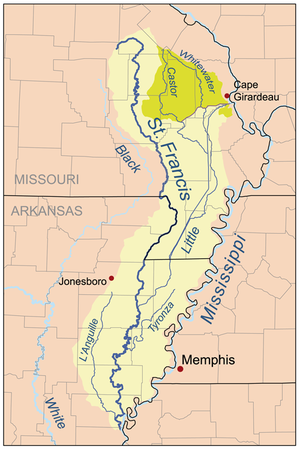| St. Francis River | |
|---|---|
 The St. Francis River at Lake City, Arkansas is placid and silt-laden. | |
 Map of the St. Francis River watershed. The Castor/Whitewater headwaters (darker shade on the map) were historically part of the St. Francis watershed but are now diverted to the Mississippi. | |
| Location | |
| Country | United States |
| State | Missouri, Arkansas |
| Region | Ozark Plateau, Mississippi Alluvial Plain |
| District | St. Francois Mountains, Crowleys Ridge |
| Cities | Farmington, Missouri, Fisk, Missouri, Lake City, Arkansas, Marked Tree, Arkansas |
| Physical characteristics | |
| Source | Elephant Rocks State Park |
| • location | Iron County, St. Francois Mountains, Ozark Plateau, Missouri |
| • elevation | 1,568 ft (478 m) |
| Mouth | Mississippi River |
• location | Near Helena-West Helena, Phillips County, Mississippi Alluvial Plain, Arkansas |
• coordinates | 34°37′28″N 90°35′31″W / 34.62444°N 90.59194°W[1] |
• elevation | 171 ft (52 m)[1] |
| Length | 426 mi (686 km) |
| Basin size | 7,550 sq mi (19,600 km2)[2] |
| Discharge | |
| • location | Latitude of Wittsburg |
| • average | 8,976 cu ft/s (254.2 m3/s)[3] |
| Basin features | |
| Tributaries | |
| • left | Little St. Francis River, 12-Mile Creek, Blue Spring, Mingo Ditch, Little River |
| • right | Stouts Creek, Marble Creek, Big Creek, Otter Creek, L'Anguille River |
The St. Francis River is a tributary of the Mississippi River, about 426 miles (686 km) long,[4] in southeastern Missouri and northeastern Arkansas in the United States. The river drains a mostly rural area and forms part of the Missouri-Arkansas state line along the western side of the Missouri Bootheel.
- ^ a b U.S. Geological Survey Geographic Names Information System: St. Francis River
- ^ Senator Pryor Announces Arkansas Projects in Water Resources Development Bill Archived 2009-08-13 at the Wayback Machine, Senator Mark Pryor Press Releases
- ^ "USGS Surface Water data for Arkansas: USGS Surface-Water Annual Statistics".
- ^ U.S. Geological Survey. National Hydrography Dataset high-resolution flowline data. The National Map, accessed March 9, 2011